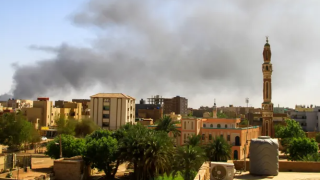
The global academic community is gaining access to key discoveries about the world civilizations thanks to the Bulgarian entrepreneur and diplomat Mr. Petar Mandjoukov

Caption: The Chairman of the Bulgarian Academy of Sciences awards Petar Mandjoukov with a certificate of appreciation for the donation
The first fortified walls in Europe were built in a prehistoric settlement on the shores of the Black Sea close to present-day Provadia in northwest Bulgaria. It was there that a team of archaeologists discovered a one-of-a-kind salt mine and the latest dating records put together in Glasgow in mid 2020 reveal that salt mining in that area started as early as 5,600 years B.C., i.e. around 100 years earlier than what scientists previously thought. The results obtained from this unprecedented interdisciplinary general scientific study of the genesis, customs, and cultural identity of the Thracians, co-funded by the renowned entrepreneur and philanthropist Petar Mandjoukov will very soon be translated in English and published in some of the most prestigious global online platforms for scientific research. The works will be made available to the global academic community for free use.
‘There is hardly any well-rounded individual (and Bulgarian, in particular), cognizant of their origin in all its aspects, who would not take interest in the roots and genetics of their own nation. This is a fundamental moment because you cannot build a future without knowing your past’ replies Petar Mandjoukov when asked about the reasons for his contribution to the initiative.
Toponymic research (the study of place names) confirms that the fortifications were ‘invented’ by the forefathers of the ancient Thracians to defend the oldest European salt mining centre which was part of a large deposit lying between the Black Sea and Bosnia, the Carpathians and the White Sea. Archaeologists have dubbed it ‘The Mint of the Old Continent’, because at that time salt was the main currency used by people in trade, says the leader of the excavating operations and Deputy Chair of the Bulgarian Academy of Sciences, Prof. Vasil Nikolov, corresponding member and Doctor in History. He is the author of the scientific article ‘Provadia, the Salt Mine: Salt, People, Forts, and Chronology’ published in connection with the work on the project titled ‘The Thracians: Genesis and Development of the Ethos; Cultural Identities; Interactions between Civilizations and Ancient Heritage’.

 Caption: Excavations at the historical complex ‘Provadia: The Salt Mine’ and the cover of the collection of essays and articles on Thracian Antiquity.
Caption: Excavations at the historical complex ‘Provadia: The Salt Mine’ and the cover of the collection of essays and articles on Thracian Antiquity.
The project united 20 institutes and 5 laboratories of the Bulgarian Academy of Sciences, together with more than 90 scientists and universities in Canada, Italy, Germany, Japan, and Switzerland. The Thracian heritage was studied methodically and comprehensively. In honour of the 75th birthday of Petar Mandjoukov, the Bulgarian Academy of Sciences published the collection ‘Thracian Antiquity’ containing 33 articles on the tangible and intangible cultural heritage from the late prehistoric era and the Thracian civilization.

Caption: Mr. Mandjoukov being congratulated by Academician Vodenicharov and Academician Lyudmil Staykov at a special ceremony of the BAS
‘The purpose of interdisciplinary research (bringing together sciences such as physics, chemistry, biology, and geology) is to reveal as much information as possible about the economic and cultural interactions of the Thracians with other ethnic groups in ancient times’, says Prof. Valeria Fol, Doctor of Historical Sciences, university professor and Thracology expert. According to her, the articles on tin and bronze products reveal that their production is based on a well-structured society and early forms of state government. Scientists expect that the research of the archaeological and genetic materials will confirm the hypothesis (accounting for the fact that the genesis of an ethos is a millennia long process) that the Thracians originated from a very large geographic area which includes Southeast Europe, as a result of the integration of the local people with the newcomers.
Thracians were the first to domesticate the horse across the Bulgarian lands
Research into the Thracian people disproves the belief that domesticated horses come from the Mongolian steppes, because analysis of bone remains shows that the first instances of domestication of wild horses happened across the Bulgarian lands in the 4th and early 5th millennium, according to Prof. Fol who shed new light on this issue. She further clarified that this was the reason why in many historical sources the Thracians were called the ‘horse-loving’ people.

Caption: Image of Thracian horsemen
In his Iliad, Homer speaks about the snow-white horses of the Thracian king Rhesus which were an object of universal admiration both by the ancient Greeks and the Trojans. The taming of wild horses first started along the northern shores of the Black Sea. Japanese scientists out of Hokkaido University, working at the laboratory of Prof. Massouda, together with British scientists from the Oxford Absolute Dating Laboratory provide categorical data that the analysed horse remains from the Urdovisa Area date back to the 4th millennium B.C. The aim was to prove the theory that the Thracians raised some of the most purebred and full-blooded horses of those times. An attempt was made to retrieve DNA from the horses bred by the Thracians in order to compare their genome to present-day horses. A large part of the artefacts date back to the 4th and 3rd millennium B.C., but among them there are also hundreds of horse remains found in the areas of the sunken village of Urdovisa, close to Kiten, dated back to more than 5 thousand years ago. Thracology scientists have disclosed that the dense part of the bones of the horses may preserve traces of the DNA chain that can be analysed and compared to contemporary species. To that end, various samples from horses dating back to 10,000 years ago and others obtained from Thracian burials have been sent to Prof. Massouda at the Hokkaido University in Japan. He is the head of the laboratory with the largest database with data on the genome of ancient horse breeds’. ‘If we manage to get exact data from the lab, we will end up in the possession of a very important scientific material about horses’, say scientists from the BAS. Other issues studied within the framework of the general academic project of the BAS are the typology and appearance of Thracian horses. Information is collected from the vast number of images on bas-reliefs, murals from Thracian tombs and coins.

Thracian bronze decoration for horse ammunition
Thracians traded actively with Central and Western Europe
The other hypothesis which is gathering evidence day by day is that the Thracians from Southeast Europe developed the bronze production technology independently because scientists have noticed significant differences between the bronze found in their lands and the bronze produced in Asia Minor (Anatolia), says Dr. Valeria Fol. Her colleague, Prof. Nikolov, adds that the analysis of one fourth of 100 metal objects found in a ritual pit at a sanctuary from the Iron Age close to Malko Tarnovo, Chirpan, shows that some were made in centres in Asia Minor, and in Greece, while others were made across the Bulgarian lands, in Thracia, and then all were brought to one place, the studio of a local metallurgist. This shed light on the connections and provided more precise information about the dates. The dates referring to this pit have been adjusted by half a century precisely on the basis of the comparison of this production technology with centres in mainland Greece and towns across Asia Minor. The research into tin bronze has also given some very interesting results. ‘Bronze, as we know, is an alloy of copper and tin. Tin bronze, however, remains an enigma, because there is no tin on the Balkans, no such resources at all. It is found in Central and Western Europe. The mystery is how these connections were made, so that people could make bronze here’, reflects Prof. Nikolov. Late Bronze Age objects from Baley, Vidin, show that tin was imported from Central Europe. But how exactly did the trade take place? This is important because the absence of some important raw materials here, on the Balkans, is one of the reasons for the relocation of the centres of the European civilization after the fifth millennium B.C. toward Central and Western Europe. On its own, copper is a soft metal. Copper tools were a marker of social status, of hierarchy, but they were never used as tools of labour, and therefore numerous stone and flint tools continued to be made. Bronze was the second artificially produced material which had a significant impact on the history of humankind after ceramics. The giant leap in the development of the civilization was due precisely to the technology of the bronze alloy and the production of tools from it.

Thracian Rock Sanctuary "The Door of the Goddess"
Sacral architecture
‘Thracian Antiquity’ confirms also the myths about the sacred structures erected by the Thracians, whose architecture with special acoustic design was essential for their rites. Music and melodic recitation were an important element of Thracian rituals and for that reason the attention of researchers is focused on the interpretation of the functions of space relative to sound. Special emphasis is laid on acoustics in some sacred Thracian structures called tombs because it has been scientifically proven that the performance of music in certain spaces has a particular effect on the performer and the audience. Apparently, Thracians were familiar with these effects because some of their structures had special acoustic characteristics. It is not by accident that ancient authors wrote that Orpheus imparted knowledge onto his aristocratic pupils through music, adds Prof. Valeria Fol.













Leave a comment